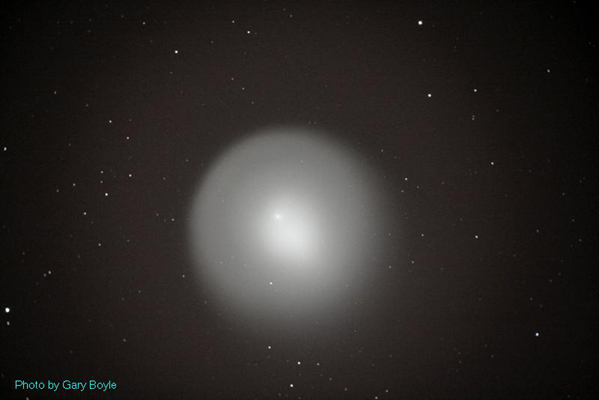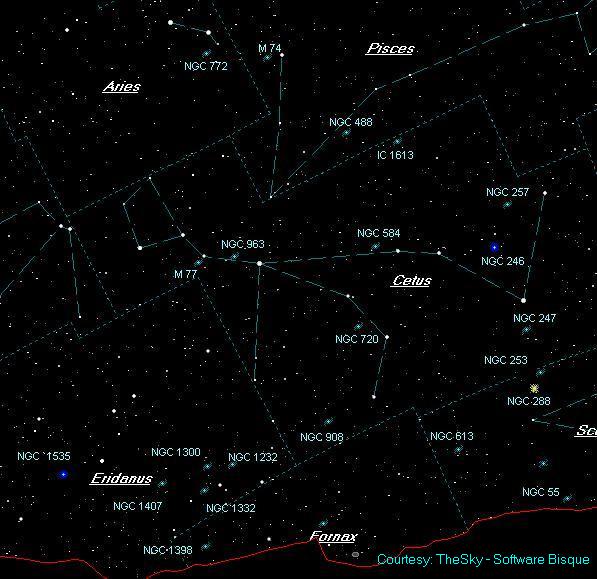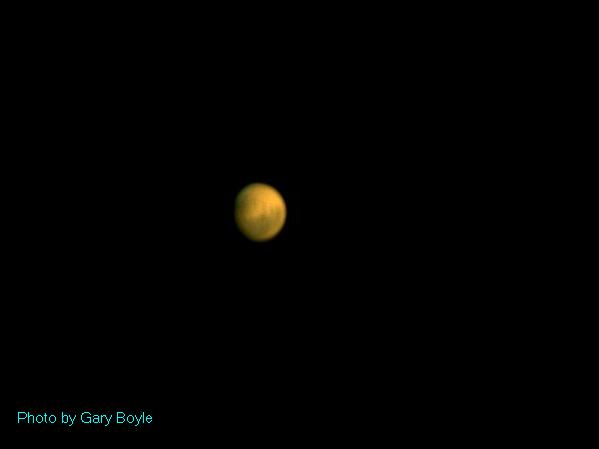What a Comet !!!
The biggest story of the month is the unexpected outburst of 17P/Comet Holmes. This outburst occurred over a short 24 hour period starting October 23rd. By the 24th, the comet had increased its brightness from magnitude 17.5 to magnitude 2.5, which is an order of one million times. At the time of writing this article, the comet halo is still growing but the inner portion is fading a bit. It is still a very impressive object.
Astronomers are not sure how long the spectacle in the North will last. We do know this comet has had previous outbursts in the past. In fact, that is how E. Holmes of England discovered it on the night of November 6, 1892. Of all thing, it was determined the comet's date of perihelion to the Sun (at a distance of 2 astronomical units) was back on August of that year and the outburst occurred when it was about a month past the Earth – as it returned to the depths of the solar system. It did, however, undergo another outburst some three months after discovery when the nucleus was spotted to be 8th magnitude and only seen in a telescope.

Comet Holmes has a 7 year return period. The 1899 return did not produce any outbursts and has been quiet until last month. A possible explanation of these sudden brightening is the Comet might possess ‘sink holes’. As Holmes rounded the Sun, gravitational forces probably weaken these areas and it gave way thus releasing an enormous amount of fresh inner material to the solar winds.
Aside from this marvel of the night let us look ahead to November skies and the constellations of Aries, Pisces, Cetus, and Eridanus areas contain some interesting objects. We first start of NGC 772, a 10.3 magnitude giant galaxy. Estimated to measure some 250,000 light-years (ly) in length, it is situated about 130 million ly away. This galaxy was quite popular back in 2003 as two supernovae were discovered over the course of three weeks. NGC 772 looks distorted thanks to a companion E3 galaxy pulling at it.
M77 in Cetus is a good example of an active galaxy. This face-on is also the prototype of the famous group of objects called the Seyfert galaxies. M77 is estimated to reside about 60 million ly away and holds a decent brightness at magnitude 8.9. NGC 488 is another face on Sb spiral galaxy. It possesses a large bright nucleus and narrow – tightly wrapped bluish coloured arms. NGC 488 lies 90 million ly away and glows at magnitude 10.3. One of two planetary nebulas featured this month is NGC 246.
Although it is listed at magnitude 10.3 it is a challenge in small telescopes due to the low surface brightness and colour. You will uncover the four stars associated with the planetary including the 12th magnitude central star but that is it. Large scopes will reveal the faint nebulosity as well as the dark hole off-center. An OIII filter will help matters.
| Object | Type | Magnitude | R.A. | Dec. |
|---|---|---|---|---|
| M 74 | Spiral galaxy | 9.2 | 01h 37m 8.9s | +15° 49' 37" |
| M 77 | Round galaxy | 8.8 | 02h 43m 7.8s | +00° 01' 13" |
| NGC 0055 | Elongated galaxy | 8.0 | 00h 15m 19.7s | -39° 08' 24" |
| NGC 0246 | Planetary nebula | 8.0 | 00h 47m 25.3s | -11° 50' 18" |
| NGC 0247 | Elongated galaxy | 8.9 | 00h 47m 31.1s | -20° 43' 20" |
| NGC 0253 | Elongated galaxy | 7.1 | 00h 48m 0.9s | -25° 14' 21" |
| NGC 0257 | Round galaxy | 14.0 | 00h 48m 31.9s | +08° 21' 45" |
| NGC 0268 | Round galaxy | 13.0 | 00h 50m 37.5s | -05° 09' 17" |
| NGC 0488 | Elongated galaxy | 10.3 | 01h 22m 14.0s | +05° 17' 39" |
| NGC 0584 | Elongated galaxy | 10.4 | 01h 31m 43.3s | -06° 49' 24" |
| NGC 0613 | Spiral galaxy | 10.0 | 00h 50m 37.5s | -05° 09' 17" |
| NGC 0720 | Elongated galaxy | 10.2 | 01h 53m 24.7s | -13° 41' 31" |
| NGC 0772 | Round galaxy | 10.3 | 01h 59m 45.5s | +19° 03' 30" |
| NGC 0908 | Elongated galaxy | 10.2 | 02h 23m 29.6s | -21° 11' 41" |
| NGC 1232 | Spiral galaxy | 9.9 | 03h 10m 11.1s | -20° 33' 00" |
| NGC 1300 | Barred spiral galaxy | 10.4 | 03h 20m 5.1s | -19° 23' 05" |
| NGC 1332 | Elongated galaxy | 10.3 | 03h 26m 40.8s | -21° 18' 08" |
| NGC 1398 | Round galaxy | 9.7 | 03h 39m 15.8s | -26° 18' 14" |
| NGC 1407 | Round galaxy | 9.8 | 03h 40m 35.0s | -18° 33' 15" |
| NGC 1535 | Planetary nebula | 10.0 | 03h 39m 15.8s | -26° 18' 14" |
The globular cluster NGC 288 measuring some 14 arc minutes across. Averted vision is required to resolve the cluster’s members. NGC 288 glows at magnitude 8.1 and is estimated to be 39,000 ly from us. Moving one and three-quarter degrees to the north and gaze at the great Sculptor Galaxy NGC 253. With wide-angle photography, you will catch both in the same portrait. Catalogued at magnitude 7.8, this almost edge-on galaxy is about as wide as the Moon taking up a half a degree of sky. Take your time on this lovely as you will pick up dark lanes, dark patches knot, and mottling.
NGC 1300 is a classic version of a barred spiral galaxy is estimated to be 75 million ly away. Its brightness is pegged at magnitude 10.5 but is diffuse because of its face-on orientation. This distant galaxy is estimated to be 150,000 ly across. Within one and a half lunar widths above NGC 1300, you will first come across NGC 1297, a magnitude 13 round galaxy.
We end off with the second planetary on the chart NGC 1535. Moderate telescopes will reveal a greenish inner disk along with a faint outer halo – all surrounding a 12th magnitude central star. NGC 1535 is a however fairly small object.

Even though Jupiter - the King of planets is now lost in the solar glare, there are five other planets to choose from. First, there is Neptune embedded in the constellation Capricornus. At magnitude 7.9, a telescope or binoculars are a must in capturing this tiny blue ball. Move over one constellation to the left to Aquarius to find brighter Uranus. This bluish-green fuzz might first look like a planetary nebula but the absent central star says it is not. Uranus is just under naked eye visibility at magnitude 5.8.
Next, we have the mysterious red planet Mars. The very prominent tinge of bright orange makes it the bright object in its base constellation of Gemini. Mars will be at its best for seeing close to Christmas. Mars will reach opposition on December 24 but is closest to the Earth on December 19 at about 88 million km. Mars and Orion (on its side) rise at the same time. The red planet begins its retrograde motion on November 15. By the end of this month, Mars will shine at magnitude -1.2. Keep following and photographing this wonderful planet.

As the night wears on, the early morning sky sets the stage for Saturn and the brilliant Venus. However, Venus is slowly sliding down to the eastern horizon but will remain a morning object until its superior conjunction on
What was a meteor storm a few years ago, the Leonids will peak on November 18th at But don’t hold your breath on this one as rates are expected to be 5 to 15 per hour. In fact, sporadic meteor (non-shower meteors) might outnumber this year’s Leonids. Observe and enjoy Comet Holmes as often as you can, before its fades.
Until next month, clear skies everyone.
Gary Boyle
